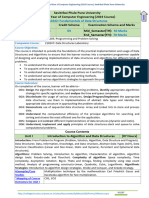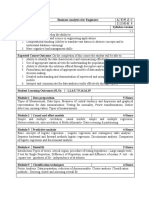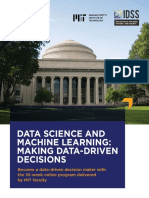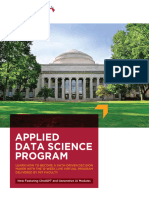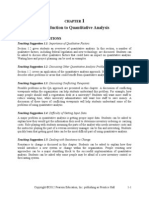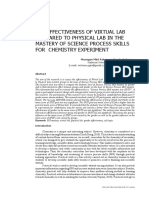ML Syllabus
ML Syllabus
Uploaded by
TORNADOCopyright:
Available Formats
ML Syllabus
ML Syllabus
Uploaded by
TORNADOCopyright
Available Formats
Share this document
Did you find this document useful?
Is this content inappropriate?
Copyright:
Available Formats
ML Syllabus
ML Syllabus
Uploaded by
TORNADOCopyright:
Available Formats
Home
Faculty of Engineering Savitribai Phule Pune University
Savitribai Phule Pune University
Fourth Year of Computer Engineering (2019 Course)
410242: Machine Learning
Teaching Scheme: Examination Scheme:
Credit
TH: 03 Hours/Week In-Sem (Paper): 30 Marks
03
End-Sem (Paper): 70 Marks
Prerequisite Courses: Data Science and Big Data Analytics(310251)
Companion Course: Laboratory Practice III(410246)
Course Objectives:
• To understand the need for Machine learning
• To explore various data pre-processing methods.
• To study and understand classification methods
• To understand the need for multi-class classifiers.
• To learn the working of clustering algorithms
• To learn fundamental neural network algorithms.
Course Outcomes:
On completion of the course, student will be able to–
CO1: Identify the needs and challenges of machine learning for real time applications.
CO2: Apply various data pre-processing techniques to simplify and speed up machine
learning algorithms.
CO3: Select and apply appropriately supervised machine learning algorithms for
real timeapplications.
CO4: Implement variants of multi-class classifier and measure its performance.
CO5 :Compare and contrast different clustering algorithms.
CO6: Design a neural network for solving engineering problems.
Course Contents
Unit I Introduction To Machine Learning 07 Hours
Introduction to Machine Learning, Comparison of Machine learning with traditional
programming, ML vs AI vs Data Science.
Types of learning: Supervised, Unsupervised, and semi-supervised, reinforcement learning
techniques, Models of Machine learning: Geometric model, Probabilistic Models, Logical Models,
Grouping and grading models, Parametric and non-parametric models.
Important Elements of Machine Learning- Data formats, Learnability, Statistical learning
approaches
#Exemplar/Case Studies Suppose you are working for Uber where a task to increase sales is
given.Understand the requirements of the client
*Mapping of Course CO1
Outcomes for Unit
Unit II Feature Engineering 07 Hours
Syllabus for Fourth Year of Computer Engineering ` #13/128
Faculty of Engineering Savitribai Phule Pune University
Concept of Feature, Preprocessing of data: Normalization and Scaling, Standardization, Managing
missing values, Introduction to Dimensionality Reduction, Principal Component Analysis (PCA),
Feature Extraction: Kernel PCA, Local Binary Pattern.
Introduction to various Feature Selection Techniques, Sequential Forward Selection, Sequential
Backward Selection.
Statistical feature engineering: count-based, Length, Mean, Median, Mode etc. based feature
vectorcreation.
Multidimensional Scaling, Matrix Factorization Techniques.
#Exemplar/CaseStudies You are a Data Scientist, and a client comes to you with their
data. Client is running a few campaigns from the past few
months, but no campaign seems effective. Client provides you the
data of customers, product sales and past campaign success.
They want to increase their sales and figure out which marketing
strategy isworking the best for them?
Questions for data scientists:
1. What data analysis approach will you follow?
2. What statistical approach do you need to follow?
How will you select important features?
*Mapping of Course CO2
Outcomes for Unit II
Unit III Supervised Learning : Regression 06 Hours
Bias, Variance, Generalization, Underfitting, Overfitting, Linear regression, Regression: Lasso
regression, Ridge regression, Gradient descent algorithm.
Evaluation Metrics: MAE, RMSE, R2
#Exemplar/Case Studies Stock market price prediction
*Mapping of Course CO3
Outcomes for Unit III
Unit IV Supervised Learning : Classification 08 Hours
Classification: K-nearest neighbour, Support vector machine.
Ensemble Learning: Bagging, Boosting, Random Forest,
Adaboost.
Binary-vs-Multiclass Classification, Balanced and Imbalanced Multiclass Classification
Problems,Variants of Multiclass Classification: One-vs-One and One-vs-All
Evaluation Metrics and Score: Accuracy, Precision, Recall, Fscore, Cross-validation, Micro-
Average Precision and Recall, Micro-Average F-score, Macro-Average Precision and Recall,
Macro-Average F-score.
#Exemplar/Case Studies Prediction of Thyroid disorders such as Hyperthyroid,
Hypothyroid, Euthyroid-sick, and Euthyroid using multiclass
classifier.
*Mapping of Course CO4
Outcomes for Unit IV
Unit V Unsupervised Learning 07 Hours
K-Means, K-medoids, Hierarchical, and Density-based Clustering, Spectral Clustering. Outlier
analysis: introduction of isolation factor, local outlier factor.
Evaluation metrics and score: elbow method, extrinsic and intrinsic methods
Syllabus for Fourth Year of Computer Engineering ` #14/128
Faculty of Engineering Savitribai Phule Pune University
#Exemplar/Case Studies Market basket analysis/Customer Segmentation
*Mapping of Course CO5
Outcomes for Unit V
Unit VI Introduction To Neural Networks 07 Hours
Artificial Neural Networks: Single Layer Neural Network, Multilayer Perceptron, Back
Propagation Learning, Functional Link Artificial Neural Network, and Radial Basis Function
Network, Activation functions,
Introduction to Recurrent Neural Networks and Convolutional Neural Networks
#Exemplar/Case Studies Movie Recommendation System
*Mapping of Course CO6
Outcomes for Unit VI
Learning Resources
Text Books:
1. Bishop, Christopher M., and Nasser M. Nasrabadi, “Pattern recognition and machine
learning”,Vol. 4.No. 4. New York: springer, 2006.
2. Ethem Alpaydin, “ Introduction to Machine Learning”, PHI 2nd Edition-2013
Reference Books:
1. Tom Mitchell, “ Machine learning”, McGraw-Hill series in Computer Science, 1997
2. Shalev-Shwartz, Shai, and Shai Ben-David, “Understanding machine learning: From
theory toalgorithms”, Cambridge university press, 2014.
3. Jiawei Han, Micheline Kamber, and Jian Pie, “Data Mining: Concepts and
Techniques”, Elsevier Publishers Third Edition, ISBN: 9780123814791,
9780123814807
4. Hastie, Trevor, et al., “The elements of statistical learning: data mining, inference, and
prediction”, Vol. 2. New York: springer, 2009.
5. McKinney, “Python for Data Analysis “,O' Reilly media, ISBN : 978-1-449-31979-3
6. Trent hauk, “Scikit-learn”, Cookbook , Packt Publishing, ISBN: 9781787286382
7. Goodfellow I.,Bengio Y. and Courville, “ A Deep Learning”, MIT Press, 2016
e-Books :
1. Python Machine Learning : http://www.ru.ac.bd/wp-
content/uploads/sites/25/2019/03/207_05_01_Rajchka_Using-Python-for-machine-
learning-2015.pdf
2. Foundation of Machine Learning: https://cs.nyu.edu/~mohri/mlbook/
3. Dive into Deep Learning: http://d2l.ai/
4. A brief introduction to machine learning for Engineers: https://arxiv.org/pdf/1709.02840.pdf
5. Feature selection: https://dl.acm.org/doi/pdf/10.5555/944919.944968
6. Introductory Machine Learning Nodes : http://lcsl.mit.edu/courses/ml/1718/MLNotes.pdf
MOOC Courses Links:
• Introduction to Machine Learning : https://nptel.ac.in/courses/106105152
• Introduction to Machine Learning (IIT Madras):
https://onlinecourses.nptel.ac.in/noc22_cs29/prevew
• Deep learning: https://nptel.ac.in/courses/106106184
Syllabus for Fourth Year of Computer Engineering ` #15/128
You might also like
- Syllabus ID5130 Parallel ScientifiC ComputingDocument2 pagesSyllabus ID5130 Parallel ScientifiC ComputingSK TamilanNo ratings yet
- AI and ML SyllabusDocument3 pagesAI and ML SyllabusDrPrashant NeheNo ratings yet
- SyllabusDocument18 pagesSyllabusAshish RoyNo ratings yet
- Gujarat Technological UniversityDocument3 pagesGujarat Technological Universityrashmin tannaNo ratings yet
- Gujarat Technological University: W.E.F. AY 2018-19Document3 pagesGujarat Technological University: W.E.F. AY 2018-19Mit PhanaseNo ratings yet
- 310251: Data Science and Big Data AnalyticsDocument2 pages310251: Data Science and Big Data Analyticssameersutane03No ratings yet
- Fds - Syllabus-2 Engineering SppuDocument8 pagesFds - Syllabus-2 Engineering Sppunerkardigambar8No ratings yet
- Gujarat Technological University: Bachelor of EngineeringDocument2 pagesGujarat Technological University: Bachelor of EngineeringJainil MaheshwariNo ratings yet
- MTECH HandbookDocument18 pagesMTECH Handbookamitk741No ratings yet
- 210242: Fundamentals of Data Structures: Prerequisite Courses: Companion Course: Course ObjectivesDocument3 pages210242: Fundamentals of Data Structures: Prerequisite Courses: Companion Course: Course ObjectivesRushikesh DeoreNo ratings yet
- NU SYLLABUS FormatDocument3 pagesNU SYLLABUS Formatsakena.benazerNo ratings yet
- Bda Aids SyllabusDocument3 pagesBda Aids Syllabusmohammadkhaja.shaikNo ratings yet
- Machine LearningDocument2 pagesMachine LearningEr Umesh ThoriyaNo ratings yet
- TBC 603 Fundamentals of Machine LearningDocument2 pagesTBC 603 Fundamentals of Machine Learningshubhamjoc2003No ratings yet
- BE Computer Engineering 2012Document60 pagesBE Computer Engineering 2012Abhijeet Babar0% (1)
- DataScience - Unit 4Document236 pagesDataScience - Unit 4sruthisureshkr2k2No ratings yet
- int 5Document12 pagesint 5maliginandini5No ratings yet
- summer trainingDocument16 pagessummer trainingterabhaijonsnowNo ratings yet
- Gujarat Technological UniversityDocument6 pagesGujarat Technological Universitytirth patelNo ratings yet
- Course Code CSA400 8 Course Type LTP Credits 4: Applied Machine LearningDocument3 pagesCourse Code CSA400 8 Course Type LTP Credits 4: Applied Machine LearningDileep singh Rathore 100353No ratings yet
- 956_BSc DataScience Semester 4 DSC D ML Paper 4Document3 pages956_BSc DataScience Semester 4 DSC D ML Paper 4laxman NyamtabadNo ratings yet
- SubSylPDF 988Document2 pagesSubSylPDF 988bonaventureagoNo ratings yet
- Mgt1051 Business-Analytics-For-Engineers TH 1.1 47 Mgt1051Document2 pagesMgt1051 Business-Analytics-For-Engineers TH 1.1 47 Mgt1051Anbarasan RNo ratings yet
- Data Science and Machine Learning Syllabus V1.0Document6 pagesData Science and Machine Learning Syllabus V1.0hafasit984No ratings yet
- Machine Learning SyllabusDocument5 pagesMachine Learning SyllabusVinodh GauNo ratings yet
- Data Mining and Business IntelligenceDocument4 pagesData Mining and Business IntelligenceMananNo ratings yet
- Advanced Machine Learing Course OutlineDocument4 pagesAdvanced Machine Learing Course OutlineAdanechNo ratings yet
- Mit Data Science ProgramDocument12 pagesMit Data Science ProgramJhomira Maribel Merino MuñozNo ratings yet
- Unit IDocument24 pagesUnit IMA DhuNo ratings yet
- National Institute of Electronics and Information Technology, ChennaiDocument5 pagesNational Institute of Electronics and Information Technology, ChennaiShubham DubeyNo ratings yet
- Lecture 1 -IntroDocument63 pagesLecture 1 -Introujjawaltomar77No ratings yet
- Mit Data Science Machine Learning Program BrochureDocument17 pagesMit Data Science Machine Learning Program BrochureSai Aartie SharmaNo ratings yet
- Data Science and Financial Engineering: Post Graduate Diploma Program inDocument3 pagesData Science and Financial Engineering: Post Graduate Diploma Program inAshwinNo ratings yet
- Epbabi Iim RanchiDocument6 pagesEpbabi Iim RanchiDarshan MaldeNo ratings yet
- Mit Data Science ProgramDocument14 pagesMit Data Science ProgramSaqib ChaudhryNo ratings yet
- Mit Data Science ProgramDocument13 pagesMit Data Science ProgramMarcos PastorNo ratings yet
- B.E Syllabus For DLDocument4 pagesB.E Syllabus For DLMishra JiNo ratings yet
- Screenshot 2024-05-28 at 12.25.15 PMDocument53 pagesScreenshot 2024-05-28 at 12.25.15 PMAkshaynayak.S Akshaynayak.SNo ratings yet
- BE Computer 2012 Course 27-8-15Document64 pagesBE Computer 2012 Course 27-8-15Bhavik ShahNo ratings yet
- Gujarat Technological University: Computer Engineering Machine Learning SUBJECT CODE: 3710216Document2 pagesGujarat Technological University: Computer Engineering Machine Learning SUBJECT CODE: 3710216Er Umesh ThoriyaNo ratings yet
- Syllabi MTech Artificial IntelligenceDocument56 pagesSyllabi MTech Artificial IntelligenceAbhignan ChakrabortyNo ratings yet
- Mit Data Science ProgramDocument15 pagesMit Data Science Programkrishna chaitu100% (1)
- Machine Learning 1Document2 pagesMachine Learning 1professorinceptionNo ratings yet
- Advanced Machine LearningDocument2 pagesAdvanced Machine LearningEr Umesh ThoriyaNo ratings yet
- Syllabus SemVIDocument14 pagesSyllabus SemVIvedant wakankarNo ratings yet
- ETI Microproject ReportDocument22 pagesETI Microproject ReportRohan PorjiNo ratings yet
- Ric JRNLDocument49 pagesRic JRNLGayatri Dilip JuwatkarNo ratings yet
- 22AIP3101A Session 1Document18 pages22AIP3101A Session 1sindhu sarlaNo ratings yet
- HandoutDocument4 pagesHandoutliquid.nitrogenNo ratings yet
- Birla Institute of Technology and Science, Pilani Pilani Campus Instruction DivisionDocument3 pagesBirla Institute of Technology and Science, Pilani Pilani Campus Instruction DivisionnaripooriNo ratings yet
- BNM842 Data Mining and Business Intelligence-2013-14Document5 pagesBNM842 Data Mining and Business Intelligence-2013-14Hernán MuñozNo ratings yet
- Syllabus: International Institute of Professional Studies Devi Ahilya University, IndoreDocument8 pagesSyllabus: International Institute of Professional Studies Devi Ahilya University, IndoreKavish SharmaNo ratings yet
- Anant MLDS FileDocument38 pagesAnant MLDS Fileabhayjadhav1281No ratings yet
- IT 7th SEM AICTE111220011103Document19 pagesIT 7th SEM AICTE1112200111031234 PradhanNo ratings yet
- The Scikit-Learn Handbook: A Guide to Machine Learning for EveryoneFrom EverandThe Scikit-Learn Handbook: A Guide to Machine Learning for EveryoneNo ratings yet
- Codeless Time Series Analysis with KNIME: A practical guide to implementing forecasting models for time series analysis applicationsFrom EverandCodeless Time Series Analysis with KNIME: A practical guide to implementing forecasting models for time series analysis applicationsNo ratings yet
- MSC Big Data Admission Notice 2021 22Document7 pagesMSC Big Data Admission Notice 2021 22ahmed ShaikhNo ratings yet
- Data Science & Machine Learning by Using R ProgrammingDocument6 pagesData Science & Machine Learning by Using R ProgrammingVikram SinghNo ratings yet
- SPC in Communication EngineeringDocument12 pagesSPC in Communication EngineeringHusaini BaharinNo ratings yet
- RSH Qam11 Ism Ch01Document7 pagesRSH Qam11 Ism Ch01James MorganNo ratings yet
- Sis Inter Final Presentation1Document38 pagesSis Inter Final Presentation1sisay mamoNo ratings yet
- Your First 90 Days As Chief Data Officer: Things To DoDocument6 pagesYour First 90 Days As Chief Data Officer: Things To DojikriNo ratings yet
- Temporal StructuresDocument306 pagesTemporal StructuresJens Birchler100% (2)
- KNN AlgorithmDocument3 pagesKNN Algorithmrr_adi94No ratings yet
- @ 2 Effects of Electronic Medical Records On Patient Safety Culture: The Perspective of NursesDocument7 pages@ 2 Effects of Electronic Medical Records On Patient Safety Culture: The Perspective of NursesElizabeth Coten100% (1)
- HBSP Resources EM Lyon - April 2017Document24 pagesHBSP Resources EM Lyon - April 2017vothiquynhyen100% (1)
- Non-Financial Factor For Make-Or-Buy Decision in Sme: Mohamed Ismail Bin Haji Pakir Mohamed Ahmad Rifa'I Bin KamarudinDocument11 pagesNon-Financial Factor For Make-Or-Buy Decision in Sme: Mohamed Ismail Bin Haji Pakir Mohamed Ahmad Rifa'I Bin KamarudinHerdin DwiyantoroNo ratings yet
- The Effectiveness of e Learning in Learning A Review of The LiteratureDocument17 pagesThe Effectiveness of e Learning in Learning A Review of The LiteratureDhita LinchNo ratings yet
- Raghav Khemka 3B RMCDocument72 pagesRaghav Khemka 3B RMCankit khemkaNo ratings yet
- An Investigation On Students Academic Performance For Junior Secondary Schools in BotswanaDocument17 pagesAn Investigation On Students Academic Performance For Junior Secondary Schools in BotswanaPancratius HokNo ratings yet
- DMAIC Templates Incl. Project CharterDocument96 pagesDMAIC Templates Incl. Project CharterArunNo ratings yet
- CH 4. BAsic Estimation TechniqueDocument27 pagesCH 4. BAsic Estimation TechniquedanarNo ratings yet
- Block 3Document36 pagesBlock 3varsha sharmaNo ratings yet
- Super Final - Account Recieavable ProjectDocument12 pagesSuper Final - Account Recieavable ProjectMaha PracharNo ratings yet
- BI in FMCGDocument30 pagesBI in FMCGRyan RubelNo ratings yet
- Auditing in The Digital Age Data Analytics and Artificial IntelligenceDocument10 pagesAuditing in The Digital Age Data Analytics and Artificial IntelligenceDavid Michael100% (1)
- 2.3 Example of Decomposition - MinitabDocument4 pages2.3 Example of Decomposition - MinitabAna Paula García ElizondoNo ratings yet
- Mean Absolute ErrorDocument2 pagesMean Absolute ErrorCinthyaNo ratings yet
- 13 Statistical Analysis Methods For Data Analysts & Data Scientists - by BTD - MediumDocument22 pages13 Statistical Analysis Methods For Data Analysts & Data Scientists - by BTD - Mediumravinder.ds7865No ratings yet
- Griya Report-Con S Eom 1704.Dwg JalanDocument11 pagesGriya Report-Con S Eom 1704.Dwg Jalansese johnNo ratings yet
- Nur Farida: Volume 04, Nomor 02, Desember 2015 Hal 142 - 155Document14 pagesNur Farida: Volume 04, Nomor 02, Desember 2015 Hal 142 - 155KiaNo ratings yet
- The Effect of Computer Addiction in The Study Habits of SHS Students 1 - 2Document28 pagesThe Effect of Computer Addiction in The Study Habits of SHS Students 1 - 2Gerlie Mendez Hernandez67% (3)
- Mean Mode RangeDocument16 pagesMean Mode RangePraise NehumambiNo ratings yet
- Flipkart Problem Employee Value Forecasting - PredictiveDocument4 pagesFlipkart Problem Employee Value Forecasting - PredictiveAshutosh SharmaNo ratings yet
- Flawlessconsulting CONVERTED To WORDDocument83 pagesFlawlessconsulting CONVERTED To WORDMia Jeruve Javier BautistaNo ratings yet
- International Project Management Guide 2.0 (IAPM)Document44 pagesInternational Project Management Guide 2.0 (IAPM)giambi-1100% (1)









